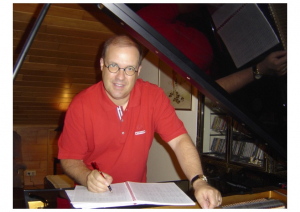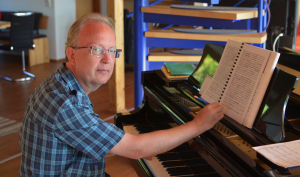The Suggested Repertoire from Around the World for Developing Bands series is a new WASBE program of instructional materials to assist music directors in identifying exceptional works from around the world that are playable by developing musicians. Each of the selections in this series provides a myriad of musical elements that might be explored and developed within the rehearsal context, but the goal is to present music of artistic merit that aligns most directly to the composer’s unique voice. These are selections that stand out from works written largely for teaching purposes.
Our installments include four-five such works, each to be contributed by WASBE members from throughout the world. The offerings include exceptional and diverse works from around the world. Some of the selections will be well known while others will be quite unfamiliar to most – and there will be more than a few older compositions that we hope will be revisited, reacquainted, or discovered anew.
This sixth installment (July 2023) is submitted by Markus Mauderer, Executive Director of WASBE and head of the Conducting Department at the Academy of Music in Staufen/Germany. Mauderer is also co-author of the repertoire compendium „600 selected works for Wind Orchestra and Wind Ensembles grade 2-3“.
Grade 2.5
ARROWS OF LIGHTNING – (10:00) – Hal Leonard
http://marcopuetz.lu/work/arrows-of-lightning-2007
Marco Pütz (Luxembourg, 1958)

The Luxembourg composer and former WASBE Board Member Marco Pütz is known for his compositions “Time for Outrage!” or “Derivations” and “Meltdown”and many more.
He also proves his own tonal language and his first-class compositional craft in educational music for youth ensembles.
The piece ” Arrows of lightning ” is a work in four movements and was written at the end of 2006.
The themes of the individual movements are partly based on traditional Indian songs, but also partly invented by the composer.
„ I have always been fascinated by the Indians, their great culture and their striving for a life in harmony with nature – a topic which has (unfortunately) become very topical again nowadays. After ” Prae Monitio ” (setting of excerpts of the memorable speech of Chief Seattle from 1855 for mezzo-soprano and wind orchestra), this is my second composition dealing with the Indian culture.“ (Marco Pütz)
The composition is written at a difficulty level of 2.5. The instrumentation is chosen in such a way that even less perfectly scored bands can play the piece.
Grade 3
HIBIKI – (6:00) – Bravo Music
https://youtu.be/WLNHZcX-A2Q
Yasuhide Ito (Japan, 1960)

Yasuhide Ito is best known to everyone for his work „Gloriosa”.
„Hibiki” is a composition of medium difficulty that I often use in conducting classes because the composition is so versatile and musically convincing despite the simple degree of difficulty.
Ito wrote this work for the junior high school band program where his eldest son went. There were only 26 students in the band program, so Ito asked the students what kind of music they would like to play. The result was “Hibiki,” which means “sound”.
Ito writes: “The subtitle is “Joy of Music”. However, the actual meaning is “Joy of being able to make music”. All the band students are full of joy just to be able to hold musical instruments and create music. The title was selected by the students.
Premiered at the 2008 Tokyo-Metropolitan Junior High School Band Association Competition, the students’ bright and cheerful appearance shined greater than their “Silver Medal“ rating“.
Optional instruments were later added to the score: piccolo, oboe, bassoon, and string bass.
Grade 3
FROM A LEGEND (A Concert Suite About Scenes From The European Middle Ages) – (08:20) – Schorer Music Publishing (HeBu Germany)
https://youtu.be/C2y_zrK0fuU
Thorsten Wollmann (Germany, 1966)

I first met Thorsten Wollmann in Trossingen (Germany) in 1993, when I was a young clarinetist at the premiere of this work.
Wollmann was still a student at the Music Conservatory in Cologne at the time and played in the German Youth Jazz Orchestra under the leadership of legendary Peter Herbolzheimer. From a Legend was commissioned for the German Federal Music Festival in Münster.
As a young trumpet player, Wollmann had early contact with wind band music, and his work From a Legend was his first multi-movement composition for wind band.
The 1st movement “In the Cathedral” opens with a solemn chorale. Its melody is based on a chromatic downward bass line. This six-bar bass repeats four times and acquires the meaning of a “basso ostinato.” The middle voices harmonize the bass in a traditional manner with much lying down and little movement. In the first bass repetition, triplet figures vary the theme; in the second repetition, there is a condensation in sixteenth notes. The third section, shortened to four measures, heightens the chorale to a major climax. The theme then concludes the atmospherically dense, darkly colored movement as a recapitulation.
The 2nd movement “Encounter At A Party”(Gigue) flows along in light, dance-like 6/8 motion. The supple melody is based on slow-moving, hollow fifths. While the dance movement begins with a regular eight-bar melody, it continues in irregularly shaped groups of bars. The longer middle section consolidates the melodic movement into a central fifth note, which is repeated as an axis thirty times as an ostinato, one-bar rhythm. The melodic action, on the other hand, shifts aperiodically to the middle and lower voices.
The 3rd movement, „The Magic Castle,” advances with the grave rhythm of a pavane. Over quiet, fifth-intensified bass passages, a melody develops with emphases on the second counting unit, as in a sarabande. The charm lies in the melody-accompanying, shimmering blended sounds that defy clear definition. The middle section contrasts with an ostinato, mirror-image four-note accompaniment.
The 4th movement, “The Conquest,” is based on an energetic, martial rhythm, performed by all percussion instruments and several wind registers, into which a summoning melody calls. The piece finally culminates in pure rhythm.
Grade 3.5
GREEK FOLK SONG SUITE NO. 2 – (10:00) – Edition Franco Cesarini
https://youtu.be/UNp21Ijruv0
Franco Cesarini (Switzerland, 1961)

The “Greek Folk Song Suite” from 2001/2002 has already been presented here by Miguel Etchegoncelay in the second installment of this repertoire series. The Swiss Composer, Flutist and Conductor Franco Cesarini wrote the sequel this year and it will be published soon.
Folk dances are widespread in Greece. In this work Franco Cesarini devoted himself to some typical traditional dances of Greek folk music, using three folk songs and elaborating them freely.
The first movement is a Kalamatianos, a festive dance whose roots go back to ancient times in the earliest writings of Homer and is considered the Greek national dance. The most striking feature is the irregular 7/8 rhythm. Depending on the occasion and the skill of the dancers, some steps may be performed by jumping and squatting.
The second movement represents a Zeibekiko. Unlike most traditional Greek dances, the Zeibekiko is not a dance performed in a group. There are no special steps to follow, only some figures.
The third movement, a Hasapiko, is a traditional dance with roots in Constantinople. The Hasapiko, which served as the inspiration for the Sirtaki, is a dance that moves from a slow to a faster tempo. Hasapiko is danced in a line or in an open circle, with each dancer placing his hands on the shoulders of his neighbor.
As in his first suite, Franco Cesarini has done an excellent job of portraying traditional Greek folk music with the timbres of a wind orchestra.
Cesarini’s compositions are always masterfully orchestrated and this another Greek folk song suite will be a great pleasure for both the musicians and the audience.
Incidentally, this suite is also available as “Greek Folk Dances, Op. 58a” for Double Wind Quintet.
Grade 3.5
ISRAELI FOLK SONGS (04:50) – Rundel Musikverlag
https://www.rundel.de/de/media/israeli_folk_songs/576
Eva Fodor (Romania/Israel, 1979)

Eva Fodor, who is now based in Germany, writes about her composition: For a long time I had the desire to make known music from Israel – the country where I grew up. In addition, it is always a central concern for me in my musical activity to combine different musical styles and eras. As a basis for “Israeli Folk Songs” I have chosen two melodies of the Jewish communities from Morocco, Tunisia and Yemen: “Zur Mishelo Achalnu” (We have eaten of his (God’s) goodness) and “Kirya yefeyfiya” (Beautiful City). I combine the traditional, Israeli oriental character of these melodies with elements from European music and with effects from the field of body percussion. The work begins with a short, dramatic introduction. The melody of the song “Zur Mishelo Achalnu” that follows is first hummed by the orchestra musicians – similar to a synagogue – and is then heard as a solo by the alto saxophone (alternatively English horn). Oriental-like secondary melodies accompany and play around this main melody, and the music builds to powerful tutti sounds. The second, faster and dance-like song, “Kirya yefeyfiya,” begins with soloistic sounds from trumpet and alto saxophone. The sonorous tutti refrain is reinforced by stomping and “Hey!” shouts. A lyrical, two-part tenor horn solo is followed by virtuosic passages from the woodwinds, which in turn lead to the second, wilder chorus. Here, powerful effects of body percussion come into play: all the wind players put their instruments aside and present a joyful mix of clapping, snapping, stomping and shouting – accompanied by the rhythms of the percussion register. Fiery sounds finally bring the “Israeli Folk Songs” to a spirited conclusion.


